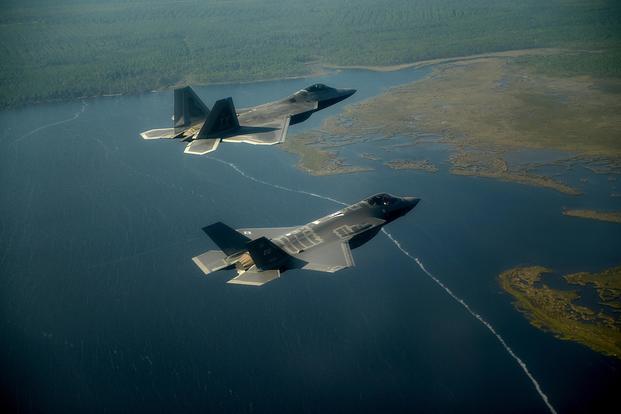With initial overseas deployments of both the F-35 Joint Strike Fighter and F-22 Raptor completed, the Air Force has a better understanding of the unique maintenance challenges required by its most advanced stealth fighters.
The service this month completed the F-35A's first training deployment to Europe and plans to permanently base a squadron of the aircraft on the continent, beginning in 2021. (The service doesn't currently have any F-35As overseas, although the Marine Corps earlier this year stationed a squadron of F-35Bs at Marine Corps Air Station Iwakuni in Japan.)
Air Force officials said much of the work needed to prepare bases abroad to accommodate the fifth-generation fighter jets made by Lockheed Martin comes down to the different processes for maintaining stealth technology on the aircraft.
"The F-22 is a fifth-generation fighter, but its stealth technology is different than what the F-35 has," Brig. Gen. Scott Pleus, a former F-16 Fighting Falcon pilot who directs the Joint Strike Fighter program integration office, recently said. For example, the Raptor's "stealth ... skin takes much more maintenance actions to maintain the stealth capabilities of the airplane than the F-35,” he said, largely because it's older technology.
Different Skin, Tooling
The Defense Department required the low observable technology for the F-35 to be more durable because the Air Force, Navy and Marine Corps each fly a variant of the aircraft designed for different scenarios, from landing on conventional runways on land, catching arresting cables on aircraft carriers, to hovering down on amphibious assault ships, Pleus explained.
The twin-engine F-22 fighter, meanwhile, was built to "just an Air Force standard," he said.
"Realize, it's a very difficult logistical challenge to move fighter planes across the ocean," Pleus said. "The Air Force makes it look very easy when we do it, because we do it all the time."
In addition, tooling, generators and aging support equipment, such as the Combined Generation and Cooling, or CGAC, cart -- which maintains the aircraft's electric power -- are distinct to each aircraft system. And as the Air Force's number of F-35As increases -- as of last September, the service had 96 in its inventory -- so, too, does the need for the support gear. "As we continue to grow the fleet, we have limited amounts of age equipment," Pleus said.
While these pieces are necessities -- like the Autonomic Logistics Information System, or ALIS, as well as the Deployable Debrief Facility, or DDF -- Pleus said bringing on additional equipment is manageable "in an overall logistics footprint, as we move overseas."
Even so, the unique maintenance challenges between the F-35 and F-22 determine what all pilots and maintainers wish they had more of -- time.
'Shortfalls' in Past Deployment
The Air Force has learned from past transatlantic flights and overseas operations, especially from the F-22's deployment two years ago.
In 2015, the Raptor made its first appearance on the continent as part of the European Reassurance Initiative, to support allies in the region following Russia's annexation of Crimea and its support for pro-Russian rebels in Ukraine. Then in 2016, the Air Force deployed a dozen F-22s from Tyndall Air Force Base in Florida to Europe for almost a month of exercises.
"We went to Spangdahlem [Air Base, Germany] in 2015 and we ran into all kinds of shortfalls -- those all made our after-action report and, about six months later, there was magically a bunch of money that went to Spangdahlem to fix those shortfalls to better host F-22s or F-35s for the next time," said Lt. Col. Daniel, an F-22 pilot of the 95th Fighter Squadron at Tyndall.
During a reporting trip to Tyndall in March, Military.com spoke with Daniel and other pilots and a maintainer at the base. All of the airmen spoke on condition their last names not be used due to safety concerns amid ongoing air operations against the Islamic State of Iraq and Syria.
The Spangdahlem shortfalls presumably had to do with maintenance on the planes’ stealth coatings, but Daniel didn't elaborate despite follow-up questions, and the after-action report wasn't shared with Military.com.
Hiccups in England
Daniel did say that crews also recently ran into minor stealth maintenance hiccups at Royal Air Forces Lakenheath in the United Kingdom, but took care of them before the F-35 landed at the base on April 15 as part of that aircraft's first training mission in Europe.
Sam, the 325th Aircraft Maintenance Squadron commander, said bases must be outfitted with the proper equipment to maintain the low observable technology, or LO.
"For example, not that I can't go there and do LO, but there are environmental controls that I need to make sure it's a little bit more effective," he said. "We're always ready to go anywhere, but how do we get there and operate more efficiently and effectively?"
New Facility in Germany
The European Reassurance Initiative, established in 2014 under President Obama to fund programs for the U.S. military conducting exercises in Europe, includes about $20 million in funding this year for infrastructure improvements so the Air Force can maintain fifth-generation fighters at bases in Europe, according to budget documents.
The program also includes money to build a low observable/composite repair facility at Spangdahlem in Germany.
In a perfect world, overseas installations would mirror those of stateside Raptor bases such as Tyndall or Langley Air Force Base in Virginia, Sam said.
"How close can I get to that same capability?" he asked. "That's what we're always working toward."
Keeping Up with Coating
Overseas, the F-22 is currently deployed in the Middle East for Operation Inherent Resolve, the Defense Department's air campaign to stamp out ISIS. Stateside, the aircraft is undergoing stealth coating upgrades at bases in Alaska and Hawaii.
"When you're talking about a low-observable platform -- the seals, the edges, where your panels meet -- that's where you get a lot of your problems with radar identifications," said John Cottam, F-22 program deputy for Lockheed Martin in Fort Worth. The company is also redoing coatings on the engine inlets through Inlet Coating Repair, or ICR, he said.
The corrosion is to be expected, Cottam said. "This has occurred right on schedule -- the material that we use has a life to it ... so it's just that we have to touch it up with new material."
Pleus said folks shouldn't read too much into the extra stealth maintenance requirements on the F-22. "Does it make the case that the F-35 is better than the F-22?" he said. "It does not."
-- Oriana Pawlyk can be reached at oriana.pawlyk@military.com. Follow her on Twitter at @Oriana0214.





























